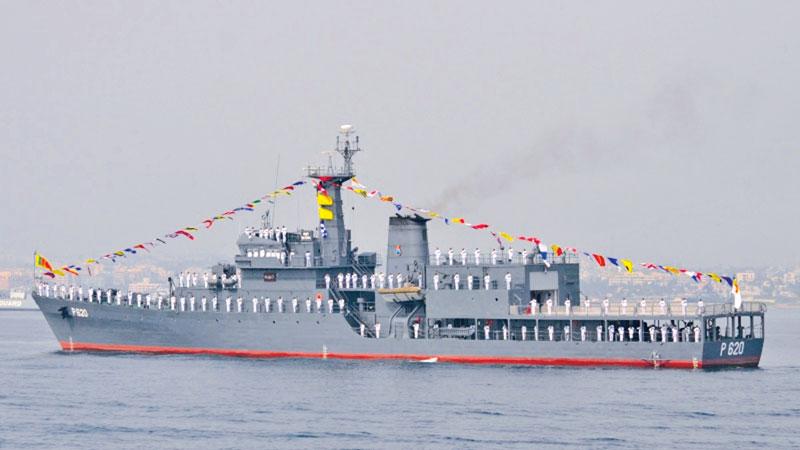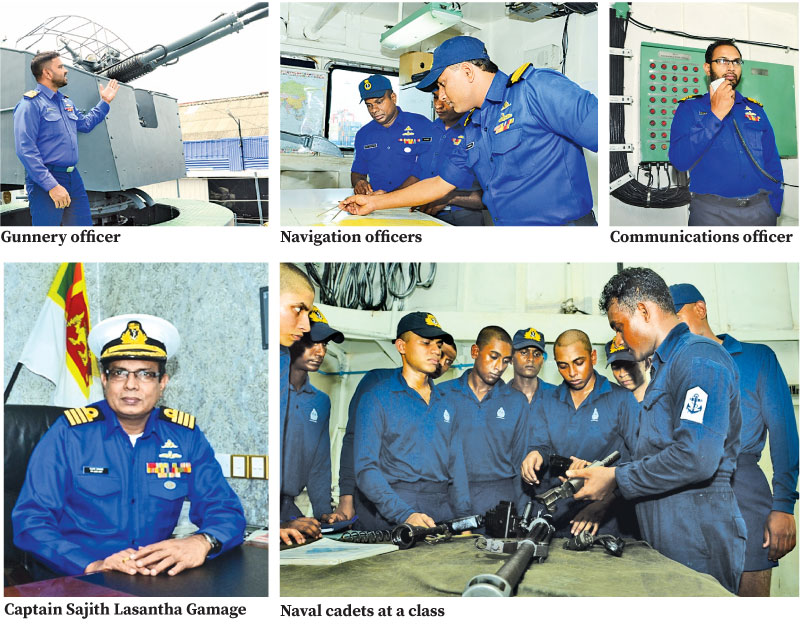
Amidst a mild wind and some tropical rain I made my entry into Colombo Port, accompanied by Lieutenant Swarnawansa. Our vehicle turned alongside the pier and I could make out the massive form of SLNS Sayura. Her first impression is that of a majestic off shore patrol vessel with twin masts. As we board the gangway the Guard Commander on duty salutes. A brass bell is suspended on an iron fitting, and the sunlight deflects off its surface. After climbing a flight of steps we enter the wardroom (officer’s mess) where a few officers are having a chat and drinking tea. Coffee is served in immaculate naval tradition.

We take another flight of steps. The iron steps on a naval vessel require focus when climbing and descending. I am ushered into the Commanding Officers cabin. Captain Sajith Lasantha Gamage is the CO of SLNS Sayura the flagship of the Sri Lanka Navy. Capt. Gamage has 30 years of experience and an expert officer in naval gunnery. He is a distinguished past student of Royal College, where he excelled in rugby. He proudly told me “The officers and sailors cherish their service on board this vessel, as she is the flagship of the Navy”. It is indeed an honour to command this magnificent vessel which has earned many battle honours and the crew is probably the best in the fleet. Sayura was commissioned on 9 December 2000 and has also been commanded by present Navy Commander Admiral Ravi Wijegunaratna. Her home port is Naval Dockyard, Trincomalee. The gallant vessel has a displacement of 1890 tons and a cruising speed of 22 knots. Her propulsion comes form 2 diesel powered engines. She has endurance (ability to go into deep sea for patrolling) for upto 20 days. Sayura has a length of 101 meters and a beam of 11.5 meters. Capt. Gamage diligently commands a crew of 15 officers and 154 crew, including naval cadets who are doing on the job training. The officers represent engineering, electrical, gunnery, signals & communication, navigation and logistics branches. The Executive Officer (second in command) is Commander. Upendra Rajakaruna.
I begin my round with a visit to the bridge. This area is the command hub of the vessel and has two key functions that support the Captain. The branches are Navigation headed by Lt.Cdr. D. Sanjeewa and Communication headed by Lt.Cdr. Lucky Dharmasena. These two sections must function in unison for Sayura to sail and achieve her given orders. Sanjeewa explains to me the about the radars and GPS systems on board. We climb to deck number 5 known as bridge top. From here one can see and observe with 360 degree view. The bridge top is used for forward observation. From her I can see the next level which is the forecastle, where the ships massive 37 mm gun is positioned on a rotating turret. This area also has the 3 anchors. Sailors are busy scrubbing and mopping this area.
We enter the bridge again and move into the chart room another vital area, where specialized radar plotters under the watch of a Petty Officer are doing some calculations using the parallel ruler. This officer monitors the weather forecast and updates the Navigation officer. Lt. Cdr. Lucky Dharmasena is the man who keeps the ship in touch with shore and other ships of the fleet. Sporting a full beard he is the text book image of a naval officer.
SLNS Sayura bears naval pennant number P620 and responds to her international call sign “4QQN’. On the bridge is the important red “action stations’ alarm which puts the entire crew for battle readiness.
The vessel also uses an assortment of flags that relay words and numerals. As I come out of the bridge the ship displays the “bravo” red flag which shows she is receiving dangerous cargo on board: in this instance two bowser loads of fuel. She also carries a detachment of elite SBS troops (Special Boat Squadron).
Capt. Gamage invites me to walk to the heli-deck. Sayura has the capacity to land a helicopter and thereby enhances her operational capability. I encounter some naval cadets clad in blue shorts and jerseys getting a lesson on gunnery. On seeing the CO they stand to attention and salute. The men can play badminton and volley ball on the heli-deck even when the vessel is out at deep sea. A gym keeps everyone fit. Captain proceeds to the lower deck where the engine room operates. Naval personnel clad in blue overalls are checking an array of displays.
This is the heart of Sayura which generates all power. The size of the two engines is impressive. Routine maintenance is mandatory onboard. Empowered with this mega propulsion SLNS Sayura deploys into deep sea to do patrolling and surveillance of our EEZ (exclusive economic zone) and also engages in anti narcotics anti smuggling operations. She also monitors IUU (illegal unreported and unregulated fishing).
Lt.Cdr. Eranda Wickramasinghe is the man in charge of another key branch on board. He is the Gunnery officer, and his team plays a crucial role as the first line of defence.
Eranda has to maintain the ships 37 mm cannon along with another array of mounted guns, magazine stores, ordinance and the gun wharf which houses ballistic helmets and body armour.
The 37mm gun has a maximum range of 8500 meters and also doubles as an anti aircraft gun. I climb the gun turret with an operator who uses a foot pedal to rotate the heavy gun. I can only imagine the devastating fire power of this gun. By 1300 hours we adjourn for dinner! On a naval vessel lunch is referred to as dinner.
The cooks have prepared a brilliant rice and curry. The chicken ambul thiyal was a unique dish. The cooks who rotate as a 4 man team prepare food for almost 200 men, not an easy task. They must cook even when the sea is turbulent.
The Logistics officer sustains the nourishment of the entire crew. Lt. Anuradha Deshappriya does the ships procurement and stores. Sayrua must carry all her fresh and dry rations including drinking water.
The cooks begin their day at 3.30 am and serve breakfast at 6am. Sea water is turned into drinking water using a reverse osmosis plant. They can turn upto 20 tons a day! This is very fascinating. Sayura also has a sick bay with trained medics on duty.
Discipline of the crew onboard this massive vessel is maintained by the Master-at- Arms, who is a MCPO (Master Chief Petty Officer). The crew has comfortable accommodation, sleeping on bunk beds.During my visit on board I heard the shrill whistle of the bosun’s pipe sending out messages. The pipe is blown by a Quarter Master. The high frequency can be heard in every section of the ship, even in the most turbulent storm. SLNS Sayura maintains the finest naval traditions and is always ready to respond and mitigate any threats at sea
